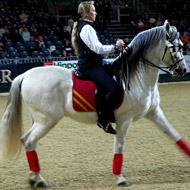
Study recommends changing compression bandages every four days
Equine leg wraps and equine compression bandages exert different amounts of pressure, according to new research.
Published in the Equine Veterinary Journal, the study found that polo wrap bandages (DLP) maintain pressure for 24 hours, while compression bandages (DLC) maintain high pressure for 96 hours.
In light of their findings, the researchers recommend changing a compression bandage once every four days, providing there is no other reason to change it.
Led by Kansas State University College of Veterinary Medicine, the analysis set out to quantify the amount of pressure both compression bandages and standing wraps exert.
In the first of three studies, the team applied DLC bandages to the limbs of eight healthy horses. Bandages were randomly assigned to the left or right forelimb using a table of random numbers.
In the second study, the team randomly assigned DLP and DLC bandages to nine healthy horses over a period of 24 hours. They recorded the horses' behaviour to identify activity or agitation that could affect the treatment. As the end of the treatment, they assessed the bandaged limbs for any signs of oedema, tendonitis, or lameness.
In the third study, the researchers placed DLC bandages on eight healthy horses over a period of 96 hours. The mares ranged in age from five to 14 and allocation of the DLC was determined by tossing a coin. As before, the researchers recorded behaviour and finished the treatment with a thorough assessment.
In all three studies, the team tracked bandage pressure using a pressure monitor. Before they placed the bandage, they attached one sensor over the dorsum of the cannon and another over the lateral aspect of the cannon and secured with adhesive tape.
The researchers found that pressure distribution was not uniform, most likely due to the natural shape of the leg. Standing wrap bandages maintained pressure for a 24 hour period but exerted less pressure than compression wraps. Meanwhile, compression wraps reduced in pressure after six to 12 hours but then remained fairly stable.
"Based on these data, four-day intervals between bandage changes may be appropriate in normal horses without limb oedema," the researchers conclude.
While the team cannot say if one wrap is superior to the other, evidence from their hospital shows that both bandage types have the ability to reduce distal limb oedema effectively.
The study, Measurement of distal limb sub-bandage pressure over 96 hours in horses, is published in the Equine Veterinary Journal.
Image (C) BS Thurner Hof



 BSAVA is to partner with BVA Live (11-12 June 2026) to champion clinical research.
BSAVA is to partner with BVA Live (11-12 June 2026) to champion clinical research.